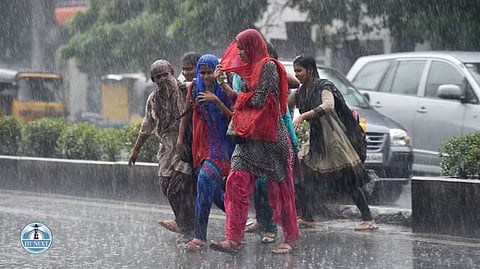

CHENNAI: The rainfall pattern in Tamil Nadu recorded severe variations in 2022 in what activists claim is the harbinger of climate change. The State usually receives nearly half of its annual rainfall during the northeast monsoon months. Last year, however, the trend varied, with Tamil Nadu receiving higher rainfall in non-monsoon months.
The data released by the India Meteorological Department (IMD) reveal that though the northeast monsoon season was normal in 2022, Tamil Nadu received 1,130.6 mm rainfall, which is 22.9 per cent more than the normal rainfall (average) of 919.8 mm.
Collating the rainfall statistics provided in the IMD’s ‘Statement on Climate for the State of Tamil Nadu: 2022’ shows that more than 60 per cent rainfall was during non-monsoon (Northeast) months, while only 39 per cent rainfall was received during the actual monsoon months.
This stands in contrast to the observed trend and long-period average, according to which the State receives 48 per cent of its annual rainfall during the October-December period (northeast monsoon season).
During the southwest monsoon months (June to September) in 2022, the State received 42.17 per cent rainfall against the usual trend of 35.70 per cent. Rainfall amounts during winter and pre-southwest monsoon seasons also recorded an increasing trend.
The statement also pointed out that the amount of rainfall on a single day has increased significantly than that of the long period average (LPA) between 1971 and 2020. As per the LPA, the State would witness less than 10 mm rain on any given day. In 2022, several days recorded more than 10 mm rainfall.
These variations were due to climate change, said G Sundarrajan of Poovulagin Nanbargal. “Climate change will result in high temperatures. It would also result in extreme rainfall years and deficient years. Receiving higher amounts of rainfall during non-northeast monsoon months is being observed for the past few years,” he said, adding that the only way to mitigate climate change was to reduce the usage of fossil fuels.
Another important aspect highlighted by the statement was the rise in mean temperature in the State. Between 1901 and 2022, the average maximum temperature has increased by 0.82 degree Celsius while the average minimum temperature has increased by 0.51 degree Celsius.
The five warmest years on record in the state were recorded during the previous decade – 2012, 2016, 2017, 2019 and 2020.
Madurai becomes drier
As the distribution of rainfall is becoming haphazard, the district-wise rainfall trends in annual rainfall for the period 1901-2021 show that the Madurai district recorded a significant decrease in rainfall, while there is a substantial rise in rainfall at Perambalur. Another meteorological report projected that the southern district would witness a further decrease in rainfall. Going by the present emission scenarios, the annual rainfall for Madurai may reduce by 4 per cent by the end of the century, the report said. By 2040, the annual rainfall in Madurai would come down by 1 per cent, it added. Taking note of the report of the district becoming drier, Madurai MP Su Venkatesan urged the State government to increase green cover in the district and to prevent the conversion of forest lands for other uses.
Visit news.dtnext.in to explore our interactive epaper!
Download the DT Next app for more exciting features!
Click here for iOS
Click here for Android